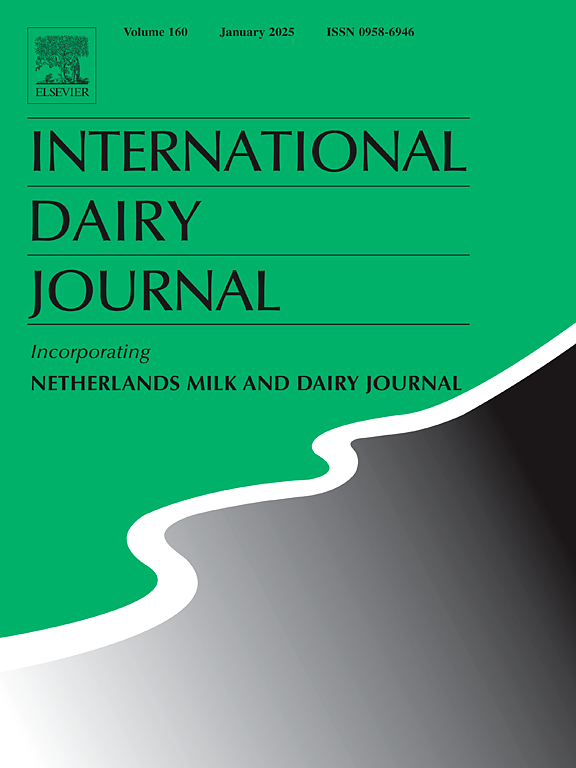Exploring molecular interactions between oleic acid and whey protein: implications for emulsification and functional properties in modern food systems by multi-technique approach
IF 3.4
3区 农林科学
Q2 FOOD SCIENCE & TECHNOLOGY
引用次数: 0
Abstract
This study investigated the interaction mechanism between Oleic acid (OA) and β-lactoglobulin (β-LG) using various biophysical techniques. UV–visible (UV–vis) spectroscopy confirmed the formation of β-LG -(OA) complexes, consistent with fluorescence data. The intrinsic fluorescence investigations showed that the quenching mechanism was static, with a decreased fluorescence quenching constant as temperatures increased. Thermodynamic parameters (ΔH < 0; ΔS < 0) confirmed the formation of a complex between OA and β-LG through hydrogen and van der Waals interactions. The interaction with OA also led to changes in the secondary structure of β-LG, as observed through FTIR and CD, which showed a transition from β-structures to α-helix. Molecular docking analysis revealed the involvement of specific residues in the binding between β-LG and OA, with a docking energy of −24.39 kJ/mol, suggesting a spontaneous interaction with moderate to high affinity. The increases in RMSD, RG were observed for the β-LG -the results of thermal stability supported (OA) complex. The findings from this study provide new insights into the interaction mechanism between β-LG and OA. The results indicate that β-LG can serve as a delivery vehicle for OA in functional food applications.
探索油酸和乳清蛋白之间的分子相互作用:多技术方法对现代食品系统乳化和功能特性的影响
本研究利用多种生物物理技术研究了油酸(OA)与β-乳球蛋白(β-LG)的相互作用机制。紫外可见光谱(UV-vis)证实了β-LG -(OA)配合物的形成,与荧光数据一致。本征荧光研究表明,荧光猝灭机制是静态的,随着温度的升高,荧光猝灭常数减小。热力学参数(ΔH <;0;ΔS & lt;0)证实了OA和β-LG之间通过氢和范德华相互作用形成络合物。与OA的相互作用也导致了β-LG二级结构的变化,通过FTIR和CD观察,从β-结构向α-螺旋结构转变。分子对接分析表明,β-LG与OA的结合中有特定残基参与,对接能量为−24.39 kJ/mol,表明这是一种具有中高亲和力的自发相互作用。热稳定性负载(OA)配合物的结果β-LG的RMSD和RG均有所增加。本研究结果为β-LG与OA的相互作用机制提供了新的认识。结果表明,β-LG可作为功能性食品中OA的递送载体。
本文章由计算机程序翻译,如有差异,请以英文原文为准。
求助全文
约1分钟内获得全文
求助全文
来源期刊

International Dairy Journal
工程技术-食品科技
CiteScore
6.50
自引率
9.70%
发文量
200
审稿时长
49 days
期刊介绍:
The International Dairy Journal publishes significant advancements in dairy science and technology in the form of research articles and critical reviews that are of relevance to the broader international dairy community. Within this scope, research on the science and technology of milk and dairy products and the nutritional and health aspects of dairy foods are included; the journal pays particular attention to applied research and its interface with the dairy industry.
The journal''s coverage includes the following, where directly applicable to dairy science and technology:
• Chemistry and physico-chemical properties of milk constituents
• Microbiology, food safety, enzymology, biotechnology
• Processing and engineering
• Emulsion science, food structure, and texture
• Raw material quality and effect on relevant products
• Flavour and off-flavour development
• Technological functionality and applications of dairy ingredients
• Sensory and consumer sciences
• Nutrition and substantiation of human health implications of milk components or dairy products
International Dairy Journal does not publish papers related to milk production, animal health and other aspects of on-farm milk production unless there is a clear relationship to dairy technology, human health or final product quality.
 求助内容:
求助内容: 应助结果提醒方式:
应助结果提醒方式:


